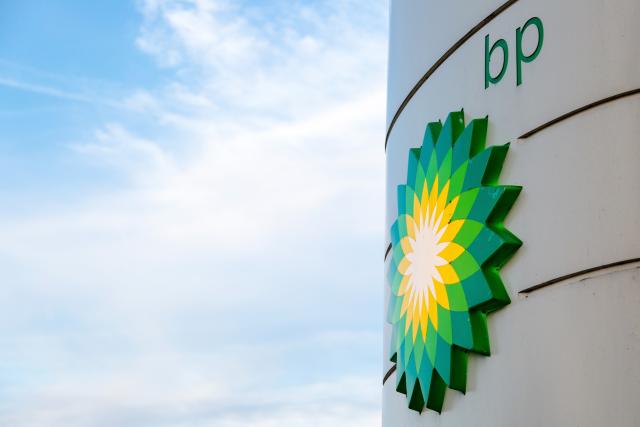
BP’s logo at a petrol station in Woking, Surrey, U.K. (Source: Shutterstock.com)
BP reported an underlying replacement cost profit attributable to its shareholders of $27.7 billion in 2022, up 116% compared to 2021. This year, BP will allocate 40% of surplus cash flow to strengthen its balance sheet and the remaining 60% for share buybacks.
BP CEO Bernard Looney said Feb. 7 during the company’s fourth quarter 2022 and year-end webcast that the results were indicative of the company’s execution of strategic plans laid out three years go to pivot from its 110-year history of being an international oil company to becoming an integrated energy company.
“I am personally in awe of what the BP team has delivered since then,” Looney said. “And all during the most volatile and uncertain times that many of us have ever experienced.”
Despite uncertainties in the market due to Russia’s invasion of Ukraine in early 2022, Looney said BP continued to control its costs and reduce emissions while investing further in both transition growth engines and traditional oil and gas, all while delivering to shareholders.
Key BP highlights from last year include:
- Average production of 2,253 Mboe/d in 2022, up 1.6% compared to 2021 despite declines in Trinidad and Tobago;
- Capex reached $16.3 billion in 2022, slightly over budget due to the phasing of BP’s acquisition of EDF Energy Services;
- Share buybacks reached $11.3 billion in 2022, and before releasing first quarter 2023 results, the company will execute a $2.8 billion share buyback from surplus cash flow; and
- Net debt fell for the 11th successive quarter to reach $21.4 billion at the end of 2022.
Wells Fargo was positive after its initial look at BP’s results.
“Pivot arrives. Operational beat on realizations, production slightly lower; [and a] 10% dividend increase,” analysts Roger D. Read and Lauren Hendrix Walker wrote Feb. 7 in a research report. BP is “to balance energy transition investment with more hydrocarbons, raising 2030 EBITDA goals materially,” they said.
Credit rating commitment, plans for 2023
In 2023, BP is committed to maintaining a strong investment grade credit rating, targeting further progress within an 'A' grade, the company revealed in its fourth quarter 2022 press release.
In the first quarter 2023, BP CFO Murray Auchincloss expects “oil prices to remain supported by recovering Chinese demand, ongoing uncertainty around the level of Russian exports and low inventory levels. The outlook for global gas prices [will] remain dependent on weather in the Northern Hemisphere and the pace of Chinese demand recovery… [as well as] industry refining margins to remain elevated due to sanctioning of Russian crude and product.”
BP expects both reported and underlying upstream production in 2023 to be broadly flat compared with 2022. By 2025 and 2030, production is expected to reach 2,300 Mboe/d and 2,000 Mboe/d respectively. The latter figure would represent a 25% decline compared to 2019, while a previous forecast called for reducing production by 40%, the company revealed during the webcast.
RELATED
BP Foresees Lower 4Q Production but Higher Commodity Prices
“As a result, BP reduced its ambitions to cut emissions from fuels sold to customers to 20%-30% by 2030, from 35%-40%,” Reuters wrote Feb. 7. “BP still aims to reduce its total emissions to net zero by 2050.”
Climate activists were infuriated by BP rowing back plans to slash fossil fuel production and reduce carbon emissions by 2030, according to the news agency.
BP aims to remain focused on its disciplined investment allocation and expects capex of between $16 billion and $18 billion in 2023. Thereafter and through 2030 the company expects annual capex of between $14 billion and $18 billion.
In terms of divestments and other proceeds in 2023, BP is eying between $2 billion and $3 billion. The company expects to reach a combined total of $25 billion in divestment and other proceeds between the second half of 2020 and 2025.
Based on BP’s current forecasts, “at around $60 per barrel Brent and subject to the board’s discretion each quarter, [BP] expects to be able to deliver share buybacks of around $4 billion per annum, at the lower end of its capital expenditure range, and have capacity for an annual increase in the dividend per ordinary share of around 4%,” the company said.
Recommended Reading
Vistra Buys Remaining Stake in Subsidiary Vistra Vision for $3.2B
2024-09-19 - Vistra Corp. will become the sole owner of its subsidiary Vistra Vision LLC, which owns various nuclear generation facilities, renewables and an energy storage business.
Kimmeridge Signs Natgas, LNG Agreement with Glencore
2024-09-19 - Under the terms of the agreement, set to be finalized later this year, Glencore will purchase 2 mtpa of LNG from Commonwealth LNG and source natural gas from Kimmeridge Texas Gas.
Matador Closes $1.8B Ameredev Deal, Updates Asset Development Plans
2024-09-19 - Matador Resources’ $1.83 billion bolt-on acquisition of the Delaware Basin’s Ameredev II adds 33,500 acres and brings the company’s inventory to approximately 2,000 net locations.
TotalEnergies Signs LNG Agreements in China, Turkey
2024-09-19 - TotalEnergies announced two separate long-term LNG sales in China and a non-binding agreement with Turkey’s BOTAŞ in an effort to grow its long-term LNG sales.
WhiteHawk Energy Adds Marcellus Shale Mineral, Royalty Assets
2024-09-18 - WhiteHawk Energy LLC said it acquired Marcellus Shale natural gas mineral and royalty interests covering 435,000 gross unit acres operated by Antero Resources, EQT, Range Resources and CNX Resources.
Comments
Add new comment
This conversation is moderated according to Hart Energy community rules. Please read the rules before joining the discussion. If you’re experiencing any technical problems, please contact our customer care team.






